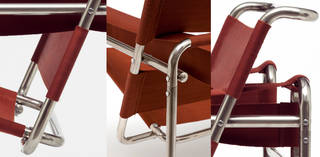How often do you think about the chairs you sit on? In Modernist circles, the chair represented a particularly important and popular design challenge. This was partly because the new interiors of the time required suitable furniture, but also because the poor economic climate during the inter-war years led many architects to pursue other opportunities to gain clients.
Literally hundreds of architects and designers produced chairs. In their shiny, chromed surfaces and mechanistic, hygienic appearance, these chairs declared the radical nature of the new interior.
Chairs at the V&A span the length and breadth of Modernist design and epitomise the era's vast and wide-ranging contribution to modern seating.
Model B3 Chair – Marcel Breuer
This chair – one of the first to be made of tubular steel – is regarded by many as the most important piece of furniture of the 20th century. Known as the Club Chair and later as the Wassily, the B3 was designed by the Hungarian-born Marcel Breuer. In 1925, after four years of studying at the Bauhaus in Germany, Breuer was appointed master of the school's furniture workshop, aged 23.


Breuer became interested in finding ways in which new materials could be used in the design of furniture suited to modern life. The B3's metal frame was inspired by a bicycle frame, and the use of tubular steel allowed the minimum use of material to achieve maximum strength. This breakthrough would inspire other architects and designers to experiment with two-legged chair design.

Model MR20 – Ludwig Mies van der Rohe
Mart Stam is credited with developing the first cantilevered chair, that is, a chair devoid of back legs that relies solely on the strength of its tubular steel front legs. The invention of a chair that had a 'floating quality' and apparently defied gravity fit perfectly with Marcel Breuer's initial notion that the modern chair should make one feel as if sitting "on a resilient column of air".

Mies van der Rohe, one of the most important figures in Modern architecture and the originator of the phrase 'Less is More', patented this curvilinear cantilevered chair model. The grace and elegance of the chair gave it instant appeal.

Mies van der Rohe was vice president of the Deutsche Werkbund, an association of artists, designers and architects who worked in partnership to create furniture and architecture using mass-production techniques. Their influential exhibition 'Die Wohnung' (The Dwelling), in 1927 included the beautifully proportioned MR chair. It has remained in production to this day.
Paimio Armchair – Alvar Aalto
From the 1930s onward, the proliferation of steel furniture led to a backlash by designers against, as Mart Stam decried, the overcomplicated 'steel macaroni monsters'. Plywood regained prominence, as did softer, more natural influences.

Designer Alvar Aalto moved away from the functional, rational coldness of metal and adapted a more human-centred approach to seating design. The Paimio armchair, built for use in the Paimio sanatorium that Aalto had also designed, used bent laminated birch wood and bent plywood to allow tuberculosis patients to rest comfortably and breathe more easily. The organic, scrolling nature of the wood shows Aalto's masterly skill in moulding the material.

Aalto's bentwood furniture had a great influence on the American designers Charles and Ray Eames and the Finnish-born Eero Saarinen.

1940s and beyond
Late-Modern chair designers, often obsessed with producing one-piece moulded furniture, continued to explore steel and plywood frames, and were helped by the introduction of fibreglass and plastics. Breuer, Mies van der Rohe, Charles and Ray Eames and others, carried on producing some of the finest examples of modern seating design, several of which are in the collection.


